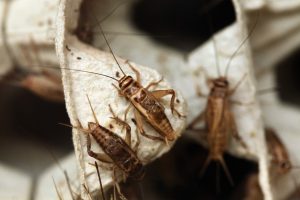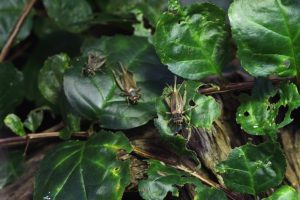CRICKETS CONTROL

Crickets are insects distantly related to grasshoppers, and scientists have identified and described more than 900 species of crickets. In nature, crickets are prey for many animals, from birds to bears, and they are a key part of the food chain. Crickets are also a popular feeder food for many pets, such as lizards and spiders. The average life span of cricket is 90 days. They can be recognized by their round heads, long antennae, cylindrical bodies, and prominent hind legs. Interestingly, they are known for their loud chirping which is caused when males rub their front wings together to attract females.
Not sure if you have a cricket problem? Or maybe you want to learn more about how cricket control works. Check out the following information to clarify some questions you may have.
Library Shortcuts
- Should I be concerned about crickets?
- Signs of crickets’ infestation
- Why do I have crickets?
- Can I get rid of crickets myself?
- Tips to prevent cricket infestations
Should I be concerned about crickets?
Crickets aren’t known to be harmful or dangerous. They are essentially just a nuisance pest, particularly if their “singing” keeps you awake at night. However, once inside your house they will eat practically anything and can cause damage to clothing and curtains in your home, they prefer a fabric that’s been soiled by food or perspiration. Although the damage is seldom, large numbers of crickets can damage clothing and other fabric items. The two most likely types of crickets to infest your home is the gray-brown house cricket and the darker colored field cricket.
Signs of crickets’ infestation
House crickets can be identified by their light brown color and the three dark bands across their heads and their size. These pests are about 3/4 of an inch in length and have large back legs, long antennae, and wings. The following are some signs that will help you identify if you have a cricket infestation:
- Physical sighting; the most obvious sign of a cricket infestation is if you spot multiple crickets inside your home.
- Chirping; Male house crickets often produce a series of two or three short, high-pitched sounds commonly known as chirping. These insects rarely chirp during the day; instead male crickets chirp mostly at night when mating or courting a female.
- Damage; routinely check your clothing and furniture for chewed-up edges. Crickets are drawn to fabrics like wool, silk, cotton, and leather, especially those stained with food or sweat.

Why do I have crickets?
Crickets thrive in warm, humid climates and tend to prefer living outside in the warmer months and will tend to be less of a problem then. They generally like to inhabit dark areas such as the basement or garage. Just like flies and mosquitoes, crickets are attracted to lights, and often flock to them by the thousands. Crickets can nest in compact crevices, so they often accumulate in cluttered areas of a home, like a garage or an attic.
These insects primarily inhabit areas with tall grasses, bushes, or trees, which makes homes with large piles of bricks, wood, or grassy flower beds more susceptible to a cricket infestation. Heavy rainstorms can draw these insects indoors at any point throughout the year, but fall is the most likely season for a cricket infestation to occur since the weather cools down and plants begin to die and they will head inside to find warmth and available food.
Can I get rid of crickets myself?
If you hear loud chirping indoors, it may be an adult male cricket calling for a mate that got into your property somehow. Follow the sound as quietly as you can, so as not to startle the insect—if you do, it can jump a good 3 feet! It’s possible to catch the cricket with your bare hands and release it outside, but make sure you wash your hands well afterward. You can also leave a plastic bottle with a small amount of soda or other sweetened drink inside. The cricket is likely to crawl in but will have trouble getting out.
Tips to prevent cricket infestations
It is easier to prevent a cricket infestation than to get rid of them afterward. The following are some tips that will help you safeguard your home from a future infestation:
- Store firewood away from the home and off the ground
- Improve crawl space ventilation to make the subspace less attractive
- Vacuum regularly in order to remove adults and eggs
- Trim bushes and move piles of wood or trash away from doors
- Keep lawn and patio tidy and clear of debris
- Avoid clutter condition by cleaning areas like garages and attics
- Patch up any holes and cracks found in your home’s foundation or exterior walls
- Change outdoor lights from white to yellow-tinted light bulbs

Want a Free Estimate?
Need to Schedule Service?
Have a Questions?
WHAT WILL WE DO?
Our cicada killer control process typically consists of the following stages:
- Confirm or discard the existence of crickets in your home through an inspection.
- Identify the factors that may be causing and contributing to the infestation.
- Offer pest control programs to get the problem under control.
- Treat the existing ant population and prevent future infestations.
What our clients are saying
Our Partners and Awards
Service Areas
New Jersey:
Ocean County
Essex County
Passaic County
Morris County
Hudson County
Bergen County









